
THE BASICS OF CLIMATE CHANGE
Greenhouse gases affect Earth’s energy balance and climate.
The Sun serves as the primary energy source for Earth’s climate. Some of the incoming sunlight is reflected directly back into space, especially by bright surfaces such as ice and clouds, and the rest is absorbed by the surface and the atmosphere. Much of this absorbed solar energy is re-emitted as heat (longwave or infrared radiation). The atmosphere in turn absorbs and re-radiates heat, some of which escapes to space. Any disturbance to this balance of incoming and outgoing energy will affect the climate. For example, small changes in the output of energy from the Sun will affect this balance directly.
If all heat energy emitted from the surface passed through the atmosphere directly into space, Earth’s average surface temperature would be tens of degrees colder than today. Greenhouse gases in the atmosphere, including water vapour, carbon dioxide, methane, and nitrous oxide, act to make the surface much warmer than this because they absorb and emit heat energy in all directions (including downwards), keeping Earth’s surface and lower atmosphere warm [FIGURE B1]. Without this greenhouse effect, life as we know it could not have evolved on our planet. Adding more greenhouse gases to the atmosphere makes it even more effective at preventing heat from escaping into space. When the energy leaving is less than the energy entering, Earth warms until a new balance is established.
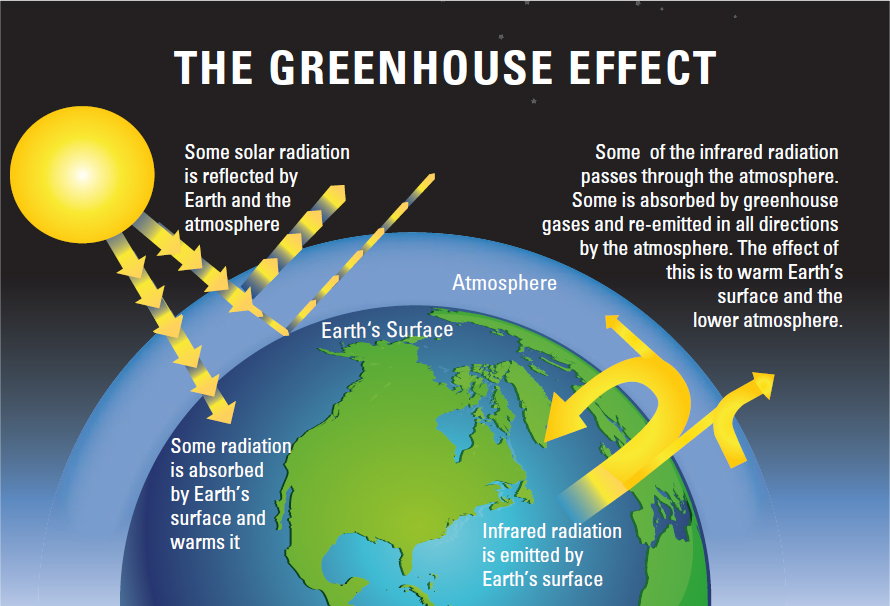
Greenhouse gases emitted by human activities alter Earth’s energy balance and thus its climate. Humans also affect climate by changing the nature of the land surfaces (for example by clearing forests for farming) and through the emission of pollutants that affect the amount and type of particles in the atmosphere.
Scientists have determined that, when all human and natural factors are considered, Earth’s climate balance has been altered towards warming, with the biggest contributor being increases in CO2.
Human activities have added greenhouse gases to the atmosphere.
The atmospheric concentrations of carbon dioxide, methane, and nitrous oxide have increased significantly since the Industrial Revolution began. In the case of carbon dioxide, the average concentration measured at the Mauna Loa Observatory in Hawaii has risen from 316 parts per million (ppm)1 in 1959 (the first full year of data available) to more than 411 ppm in 2019 [FIGURE B2]. The same rates of increase have since been recorded at numerous other stations worldwide. Since preindustrial times, the atmospheric concentration of CO2 has increased by over 40%, methane has increased by more than 150%, and nitrous oxide has increased by roughly 20%. More than half of the increase in CO2 has occurred since 1970. Increases in all three gases contribute to warming of Earth, with the increase in CO2 playing the largest role. See page B3 to learn about the sources of human emitted greenhouse gases.
Scientists have examined greenhouse gases in the context of the past. Analysis of air trapped inside ice that has been accumulating over time in Antarctica shows that the CO2
___________________
1that is, for every million molecules in the air, 316 of them were CO2
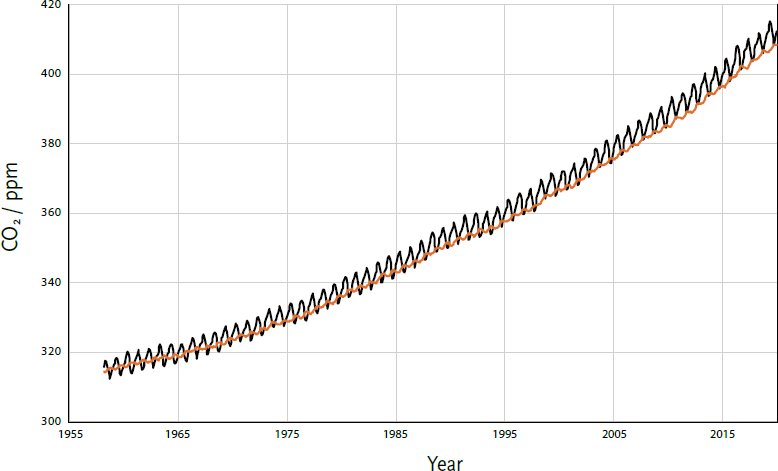
concentration began to increase significantly in the 19th century [FIGURE B3], after staying in the range of 260 to 280 ppm for the previous 10,000 years. Ice core records extending back 800,000 years show that during that time, CO2 concentrations remained within the range of 170 to 300 ppm throughout many “ice age” cycles — see infobox, pg. B4 to learn about the ice ages — and no concentration above 300 ppm is seen in ice core records until the past 200 years.
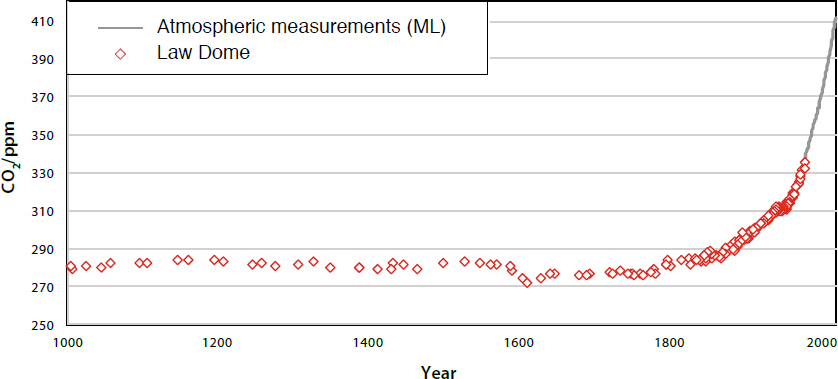
Measurements of the forms (isotopes) of carbon in the modern atmosphere show a clear fingerprint of the addition of “old” carbon (depleted in natural radioactive 14C) coming from the combustion of fossil fuels (as opposed to “newer” carbon coming from living systems). In addition, it is known that human activities (excluding land use changes) currently emit an estimated 10 billion tonnes of carbon each year, mostly by burning fossil fuels, which is more than enough to explain the observed increase in concentration.
These and other lines of evidence point conclusively to the fact that the elevated CO2 concentration in our atmosphere is the result of human activities.
Climate records show a warming trend.
Estimating global average surface air temperature increase requires careful analysis of millions of measurements from around the world, including from land stations, ships, and satellites. Despite the many complications of synthesising such data, multiple independent teams have concluded separately and unanimously that global average surface air temperature has risen by about 1 °C (1.8 °F) since 1900 [FIGURE B4]. Although the record shows several pauses and accelerations in the increasing trend, each of the last four decades has been warmer than any other decade in the instrumental record since 1850.
Going further back in time before accurate thermometers were widely available, temperatures can be reconstructed using climate-sensitive indicators “proxies”
in materials such as tree rings, ice cores, and marine sediments. Comparisons of the thermometer record with these proxy measurements suggest that the time since the early 1980s has been the warmest 40-year period in at least eight centuries, and that global temperature is rising towards peak temperatures last seen 5,000 to 10,000 years ago in the warmest part of our current interglacial period.
Many other impacts associated with the warming trend have become evident in recent years. Arctic summer sea ice cover has shrunk dramatically. The heat content of the ocean has increased. Global average sea level has risen by approximately 16 cm (6 inches) since 1901, due both to the expansion of warmer ocean water and to the addition of melt waters from glaciers and ice sheets on land. Warming and precipitation changes are altering the geographical ranges of many plant and animal species and the timing of their life cycles. In addition to the effects on climate, some of the excess CO2in the atmosphere is being taken up by the ocean, changing its chemical composition (causing ocean acidification).
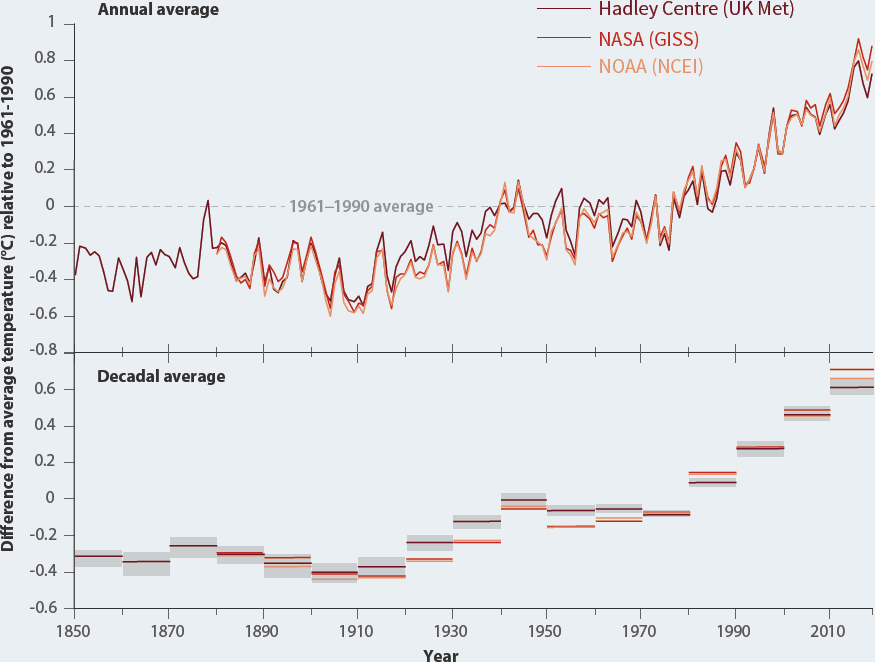
Many complex processes shape our climate.
Based just on the physics of the amount of energy that CO2 absorbs and emits, a doubling of atmospheric CO2 concentration from pre-industrial levels (up to about 560 ppm) would by itself cause a global average temperature increase of about 1 °C (1.8 °F). In the overall climate system, however, things are more complex; warming leads to further effects (feedbacks) that either amplify or diminish the initial warming.
The most important feedbacks involve various forms of water. A warmer atmosphere generally contains more water vapour. Water vapour is a potent greenhouse gas, thus causing more warming; its short lifetime in the atmosphere keeps its increase largely in step with warming. Thus, water vapour is treated as an amplifier, and not a driver, of climate change. Higher temperatures in the polar regions melt sea ice and reduce seasonal snow cover, exposing a darker ocean and land surface that can absorb more heat, causing further warming. Another important but uncertain feedback concerns changes in clouds. Warming and increases in water vapour together may cause cloud cover to increase or decrease which can either amplify or dampen temperature change depending on the changes in the horizontal extent, altitude, and properties of clouds. The latest assessment of the science indicates that the overall net global effect of cloud changes is likely to be to amplify warming.

The ocean moderates climate change. The ocean is a huge heat reservoir, but it is difficult to heat its full depth because warm water tends to stay near the surface. The rate at which heat is transferred to the deep ocean is therefore slow; it varies from year to year and from decade to decade, and it helps to determine the pace of warming at the surface. Observations of the sub-surface ocean are limited prior to about 1970, but since then, warming of the upper 700 m (2,300 feet) is readily apparent, and deeper warming is also clearly observed since about 1990.
Surface temperatures and rainfall in most regions vary greatly from the global average because of geographical location, in particular latitude and continental position. Both the average values of temperature, rainfall, and their extremes (which generally have the largest impacts on natural systems and human infrastructure), are also strongly affected by local patterns of winds.
Estimating the effects of feedback processes, the pace of the warming, and regional climate change requires the use of mathematical models of the atmosphere, ocean, land, and ice (the cryosphere) built upon established laws of physics and the latest understanding of the physical, chemical and biological processes affecting climate, and run on powerful computers. Models vary in their projections of how much additional warming to expect (depending on the type of model and on assumptions used in simulating certain climate processes, particularly cloud formation and ocean mixing), but all such models agree that the overall net effect of feedbacks is to amplify warming.
Human activities are changing the climate.
Rigorous analysis of all data and lines of evidence shows that most of the observed global warming over the past 50 years or so cannot be explained by natural causes and instead requires a significant role for the influence of human activities.
In order to discern the human influence on climate, scientists must consider many natural variations that affect temperature, precipitation, and other aspects of climate from local to global scale, on timescales from days to decades and longer. One natural variation is the El Niño Southern Oscillation (ENSO), an irregular alternation between warming and cooling (lasting about two to seven years) in the equatorial Pacific Ocean that causes significant year-to-year regional and global shifts in temperature and rainfall patterns. Volcanic eruptions also alter climate, in part increasing the amount of small (aerosol) particles in the stratosphere that reflect or absorb sunlight, leading to a short-term surface cooling lasting typically about two to three years. Over hundreds of thousands of years, slow, recurring variations in Earth’s orbit around the Sun, which alter the distribution of solar energy received by Earth, have been enough to trigger the ice age cycles of the past 800,000 years.
Fingerprinting is a powerful way of studying the causes of climate change. Different influences on climate lead to different patterns seen in climate records. This becomes obvious when scientists probe beyond changes in the average temperature of the planet and look more closely at geographical and temporal patterns of climate change. For example, an increase in the Sun’s energy output will lead to a very different pattern of temperature change (across Earth’s surface and vertically in the atmosphere) compared to that induced by an increase in CO2 concentration. Observed atmospheric temperature changes show a fingerprint much
closer to that of a long-term CO2 increase than to that of a fluctuating Sun alone. Scientists routinely test whether purely natural changes in the Sun, volcanic activity, or internal climate variability could plausibly explain the patterns of change they have observed in many different aspects of the climate system. These analyses have shown that the observed climate changes of the past several decades cannot be explained just by natural factors.
How will climate change in the future?
Scientists have made major advances in the observations, theory, and modelling of Earth’s climate system, and these advances have enabled them to project future climate change with increasing confidence. Nevertheless, several major issues make it impossible to give precise estimates of how global or regional temperature trends will evolve decade by decade into the future. Firstly, we cannot predict how much CO2 human activities will emit, as this depends on factors such as how the global economy develops and how society’s production and consumption of energy changes in the coming decades. Secondly, with current understanding of the complexities of how climate feedbacks operate, there is a range of possible outcomes, even for a particular scenario of CO2 emissions. Finally, over timescales of a decade or so, natural variability can modulate the effects of an underlying trend in temperature. Taken together, all model projections indicate that Earth will continue to warm considerably more over the next few decades to centuries. If there were no technological or policy changes to reduce emission trends from their current trajectory, then further globally-averaged warming of 2.6 to 4.8 °C (4.7 to 8.6 °F) in addition to that which has already occurred would be expected during the 21st century [FIGURE B5]. Projecting what those ranges will mean for the climate experienced at any particular location is a challenging scientific problem, but estimates are continuing to improve as regional and local-scale models advance.
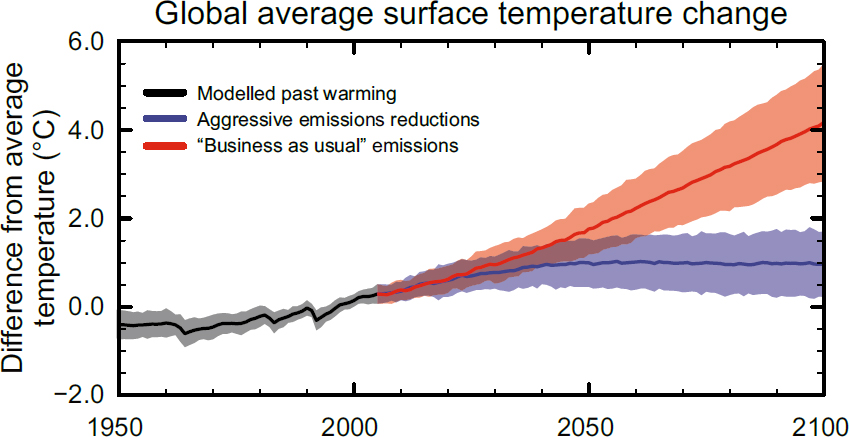
__________________
Q&A
11
IF THE WORLD IS WARMING, WHY ARE SOME WINTERS AND SUMMERS STILL VERY COLD?
Climate change means not only changes in globally averaged surface temperature, but also changes in atmospheric circulation, in the size and patterns of natural climate variations, and in local weather. La Niña events shift weather patterns so that some regions are made wetter, and wet summers are generally cooler. Stronger winds from polar regions can contribute to an occasional colder winter. In a similar way, the persistence of one phase of an atmospheric circulation pattern known as the North Atlantic Oscillation has contributed to several recent cold winters in Europe, eastern North America, and northern Asia.
Atmospheric and ocean circulation patterns will evolve as Earth warms and will influence storm tracks and many other aspects of the weather. Global warming tilts the odds in favour of more warm days and seasons and fewer cold days and seasons. For example, across the continental United States in the 1960s there were more daily record low temperatures than record highs, but in the 2000s there were more than twice as many record highs as record lows. Another important example of tilting the odds is that over recent decades heatwaves have increased in frequency in large parts of Europe, Asia, South America, and Australia. Marine heat waves are also increasing.

12
WHY IS ARCTIC SEA ICE DECREASING WHILE ANTARCTIC SEA ICE HAS CHANGED LITTLE?
Some differences in seasonal sea ice extent between the Arctic and Antarctic are due to basic geography and its influence on atmospheric and oceanic circulation. The Arctic is an ocean basin surrounded largely by mountainous continental land masses, and Antarctica is a continent surrounded by ocean. In the Arctic, sea ice extent is limited by the surrounding land masses. In the Southern Ocean winter, sea ice can expand freely into the surrounding ocean, with its southern boundary set by the coastline of Antarctica. Because Antarctic sea ice forms at latitudes further from the South Pole (and closer to the equator), less ice survives the summer. Sea ice extent in both poles changes seasonally; however, longer-term variability in summer and winter ice extent is different in each hemisphere, due in part to these basic geographical differences.
Sea ice in the Arctic has decreased dramatically since the late 1970s, particularly in summer and autumn. Since the satellite record began in 1978, the yearly minimum Arctic sea ice extent (which occurs in September) has decreased by about 40% [FIGURE 5]. Ice cover expands again each Arctic winter, but the ice is thinner than it used to be. Estimates of past sea ice extent suggest that this decline may be unprecedented in at least the past 1,450 years. Because sea ice is highly reflective, warming is amplified as the ice decreases and more sunshine is absorbed by the darker underlying ocean surface.
Sea ice in the Antarctic showed a slight increase in overall extent from 1979 to 2014, although some areas, such as that to the west of the Antarctic Peninsula experienced a decrease. Short-term trends in the Southern Ocean, such as those observed, can readily occur from natural variability of the atmosphere, ocean and sea ice system. Changes in surface wind patterns around the continent contributed to the Antarctic pattern of sea ice change; ocean factors such as the addition of cool fresh water from melting ice shelves may also have played a role. However, after 2014, Antarctic ice extent began to decline, reaching a record low (within the 40 years of satellite data) in 2017, and remaining low in the following two years.

13
HOW DOES CLIMATE CHANGE AFFECT THE STRENGTH AND FREQUENCY OF FLOODS, DROUGHTS, HURRICANES, AND TORNADOES?
As Earth’s climate has warmed, more frequent and more intense weather events have both been observed around the world. Scientists typically identify these weather events as “extreme” if they are unlike 90% or 95% of similar weather events that happened before in the same region. Many factors contribute to any individual extreme weather event—including patterns of natural climate variability, such as El Niño and La Niña—making it challenging to attribute any particular extreme event to human-caused climate change. However, studies can show whether the warming climate made an event more severe or more likely to happen.
A warming climate can contribute to the intensity of heat waves by increasing the chances of very hot days and nights. Climate warming also increases evaporation on land, which can worsen drought and create conditions more prone to wildfire and a longer wildfire season. A warming atmosphere is also associated with heavier precipitation events (rain and snowstorms) through increases in the air’s capacity to hold moisture. El Niño events favour drought in many tropical and subtropical land areas, while La Niña events promote wetter conditions in many places. These short-term and regional variations are expected to become more extreme in a warming climate.
Earth’s warmer and moister atmosphere and warmer oceans make it likely that the strongest hurricanes will be more intense, produce more rainfall, affect new areas, and possibly be larger and longer-lived. This is supported by available observational evidence in the North Atlantic. In addition, sea level rise (see Question 14) increases the amount of seawater that is pushed on to shore during coastal storms, which, along with more rainfall produced by the storms, can result in more destructive storm surges and flooding. While global warming is likely making hurricanes more intense, the change in the number of hurricanes each year is quite uncertain. This remains a subject of ongoing research.
Some conditions favourable for strong thunderstorms that spawn tornadoes are expected to increase with warming, but uncertainty exists in other factors that affect tornado formation, such as changes in the vertical and horizontal variations of winds.

14
HOW FAST IS SEA LEVEL RISING?
This sea level rise has been driven by expansion of water volume as the ocean warms, melting of mountain glaciers in all regions of the world, and mass losses from the Greenland and Antarctic ice sheets. All of these result from a warming climate. Fluctuations in sea level also occur due to changes in the amounts of water stored on land. The amount of sea level change experienced at any given location also depends on a variety of other factors, including whether regional geological processes and rebound of the land weighted down by previous ice sheets are causing the land itself to rise or sink, and whether changes in winds and currents are piling ocean water against some coasts or moving water away.
The effects of rising sea level are felt most acutely in the increased frequency and intensity of occasional storm surges. If CO2 and other greenhouse gases continue to increase on their current trajectories, it is projected that sea level may rise, at minimum, by a further 0.4 to 0.8 m (1.3 to 2.6 feet) by 2100, although future ice sheet melt could make these values considerably higher. Moreover, rising sea levels will not stop in 2100; sea levels will be much higher in the following centuries as the sea continues to take up heat and glaciers continue to retreat. It remains difficult to predict the details of how the Greenland and Antarctic Ice Sheets will respond to continued warming, but it is thought that Greenland and perhaps West Antarctica will continue to lose mass, whereas the colder parts of Antarctica could gain mass as they receive more snowfall from warmer air that contains more moisture. Sea level in the last interglacial (warm) period around 125,000 years ago peaked at probably 5 to 10 m above the present level. During this period, the polar regions were warmer than they are today. This suggests that, over millennia, long periods of increased warmth will lead to very significant loss of parts of the Greenland and Antarctic Ice Sheets and to consequent sea level rise.

15
WHAT IS OCEAN ACIDIFICATION AND WHY DOES IT MATTER?
CO2 dissolves in water to form a weak acid, and the oceans have absorbed about a third of the CO2 resulting from human activities, leading to a steady decrease in ocean pH levels. With increasing atmospheric CO2, this chemical balance will change even more during the next century. Laboratory and other experiments show that under high CO2 and in more acidic waters, some marine species have misshapen shells and lower growth rates, although the effect varies among species. Acidification also alters the cycling of nutrients and many other elements and compounds in the ocean, and it is likely to shift the competitive advantage among species, with as-yet-to-be-determined impacts on marine ecosystems and the food web.
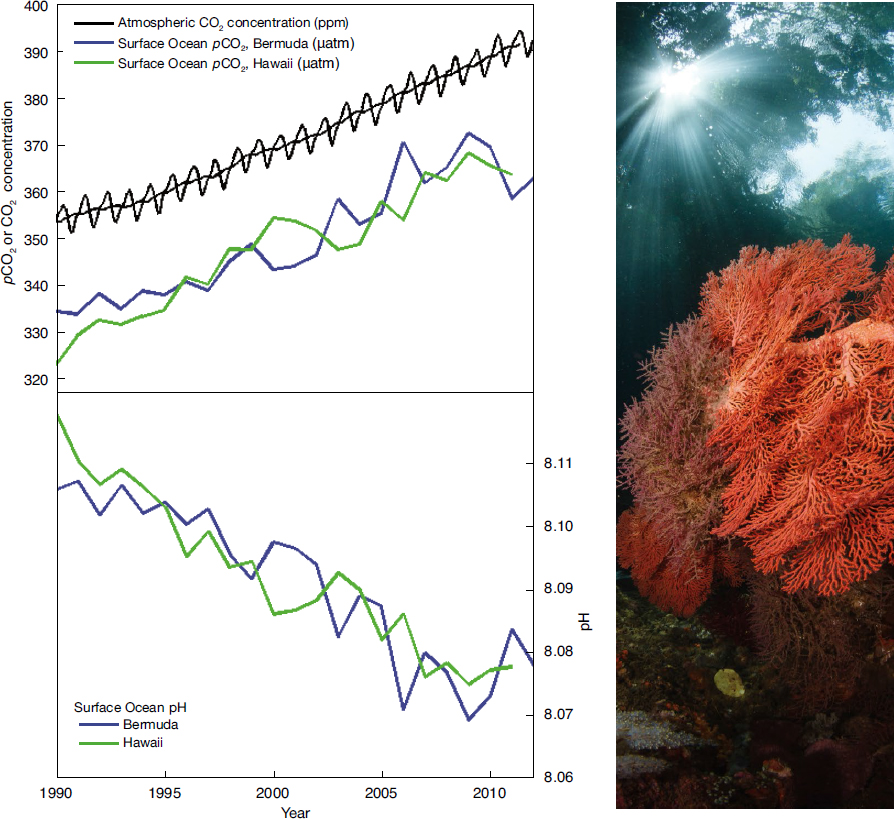
16
HOW CONFIDENT ARE SCIENTISTS THAT EARTH WILL WARM FURTHER OVER THE COMING CENTURY?
Warming due to the addition of large amounts of greenhouse gases to the atmosphere can be understood in terms of very basic properties of greenhouse gases. It will in turn lead to many changes in natural climate processes, with a net effect of amplifying the warming. The size of the warming that will be experienced depends largely on the amount of greenhouse gases accumulating in the atmosphere and hence on the trajectory of emissions. If the total cumulative emissions since 1875 are kept below about 900 gigatonnes (900 billion tonnes) of carbon, then there is a two-thirds chance of keeping the rise in global average temperature since the pre-industrial period below 2 °C (3.6 °F). However, two-thirds of this amount has already been emitted. A target of keeping global average temperature rise below 1.5 °C (2.7 °F) would allow for even less total cumulative emissions since 1875.
Based just on the established physics of the amount of heat CO2 absorbs and emits, a doubling of atmospheric CO2 concentration from preindustrial levels (up to about 560 ppm) would by itself, without amplification by any other effects, cause a global average temperature increase of about 1 °C (1.8 °F). However, the total amount of warming from a given amount of emissions depends on chains of effects (feedbacks) that can individually either amplify or diminish the initial warming.
The most important amplifying feedback is caused by water vapour, which is a potent greenhouse gas. As CO2 increases and warms the atmosphere, the warmer air can hold more moisture and trap more heat in the lower atmosphere. Also, as Arctic sea ice and glaciers melt, more sunlight is absorbed into the darker underlying land and ocean surfaces, causing further warming and further melting of ice and snow. The biggest uncertainty in our understanding of feedbacks relates to clouds (which can have both positive and negative feedbacks), and how the properties of clouds will change in response to climate change.

Other important feedbacks involve the carbon cycle. Currently the land and oceans together absorb about half of the CO2 emitted from human activities, but the capacities of land and ocean to store additional carbon are expected to decrease with additional warming, leading to faster increases in atmospheric CO2 and faster warming. Models vary in their projections of how much additional warming to expect, but all such models agree that the overall net effect of feedbacks is to amplify the warming.
17
ARE CLIMATE CHANGES OF A FEW DEGREES A CAUSE FOR CONCERN?
Both theory and direct observations have confirmed that global warming is associated with greater warming over land than oceans, moistening of the atmosphere, shifts in regional precipitation patterns, increases in extreme weather events, ocean acidification, melting glaciers, and rising sea levels (which increases the risk of coastal inundation and storm surge). Already, record high temperatures are on average significantly outpacing record low temperatures, wet areas are becoming wetter as dry areas are becoming drier, heavy rainstorms have become heavier, and snowpacks (an important source of freshwater for many regions) are decreasing.
These impacts are expected to increase with greater warming and will threaten food production, freshwater supplies, coastal infrastructure, and especially the welfare of the huge population currently living in low-lying areas. Even though certain regions may realise some local benefit from the warming, the long-term consequences overall will be disruptive.
It is not only an increase of a few degrees in global average temperature that is cause for concern—the pace at which this warming occurs is also important (see Question 6). Rapid human-caused climate changes mean that less time is available to allow for adaptation measures to be put in place or for ecosystems to adapt, posing greater risks in areas vulnerable to more intense extreme weather events and rising sea levels.
18
WHAT ARE SCIENTISTS DOING TO ADDRESS KEY UNCERTAINTIES IN OUR UNDERSTANDING OF THE CLIMATE SYSTEM?
Comparisons of model predictions with observations identify what is well-understood and, at the same time, reveal uncertainties or gaps in our understanding. This helps to set priorities for new research. Vigilant monitoring of the entire climate system—the atmosphere, oceans, land, and ice—is therefore critical, as the climate system may be full of surprises.
Together, field and laboratory data and theoretical understanding are used to advance models of Earth’s climate system and to improve representation of key processes in them, especially those associated with clouds, aerosols, and transport of heat into the oceans. This is critical for accurately simulating climate change and associated changes in severe weather, especially at the regional and local scales important for policy decisions.
Simulating how clouds will change with warming and in turn may affect warming remains one of the major challenges for global climate models, in part because different cloud types have different impacts on climate, and the many cloud processes occur on scales smaller than most current models can resolve. Greater computer power is already allowing for some of these processes to be resolved in the new generation of models.
Dozens of groups and research institutions work on climate models, and scientists are now able to analyse results from essentially all of the world’s major Earth-System Models and compare them with each other and with observations. Such opportunities are of tremendous benefit in bringing out the strengths and weaknesses of various models and diagnosing the causes of differences among models, so that research can focus on the relevant processes. Differences among models allow estimates to be made of the uncertainties in projections of future climate change. Additionally, large archives of results from many different models help scientists to identify aspects of climate change projections that are robust and that can be interpreted in terms of known physical mechanisms.
Studying how climate responded to major changes in the past is another way of checking that we understand how different processes work and that models are capable of performing reliably under a wide range of conditions.
19
ARE DISASTER SCENARIOS ABOUT TIPPING POINTS LIKE “TURNING OFF THE GULF STREAM” AND RELEASE OF METHANE FROM THE ARCTIC A CAUSE FOR CONCERN?
The composition of the atmosphere is changing towards conditions that have not been experienced for millions of years, so we are headed for unknown territory, and uncertainty is large. The climate system involves many competing processes that could switch the climate into a different state once a threshold has been exceeded.
A well-known example is the south-north ocean overturning circulation, which is maintained by cold salty water sinking in the North Atlantic and involves the transport of extra heat to the North Atlantic via the Gulf Stream. During the last ice age, pulses of freshwater from the melting ice sheet over North America led to slowing down of this overturning circulation. This in turn caused widespread changes in climate around the Northern Hemisphere. Freshening of the North Atlantic from the melting of the Greenland ice sheet is gradual, however, and hence is not expected to cause abrupt changes.
Another concern relates to the Arctic, where substantial warming could destabilise methane (a greenhouse gas) trapped in ocean sediments and permafrost, potentially leading to a rapid release of a large amount of methane. If such a rapid release occurred, then major, fast climate changes would ensue. Such high-risk changes are considered unlikely in this century, but are by definition hard to predict. Scientists are therefore continuing to study the possibility of exceeding such tipping points, beyond which we risk large and abrupt changes.
In addition to abrupt changes in the climate system itself, steady climate change can cross thresholds that trigger abrupt changes in other systems. In human systems, for example, infrastructure has typically been built to accommodate the climate variability at the time of construction. Gradual climate changes can cause abrupt changes in the utility of the infrastructure—such as when rising sea levels suddenly surpass sea walls, or when thawing permafrost causes the sudden collapse of pipelines, buildings, or roads. In natural systems, as air and water temperatures rise, some species—such as the mountain pika and many ocean corals—will no longer be able to survive in their current habitats and will be forced to relocate (if possible) or rapidly adapt. Other species may fare better in the new conditions, causing abrupt shifts in the balance of ecosystems; for example, warmer temperatures have allowed more bark beetles to survive over winter in some regions, where beetle outbreaks have destroyed forests.

20
IF EMISSIONS OF GREENHOUSE GASES WERE STOPPED, WOULD THE CLIMATE RETURN TO THE CONDITIONS OF 200 YEARS AGO?
If emissions of CO2 stopped altogether, it would take many thousands of years for atmospheric CO2 to return to “pre-industrial” levels due to its very slow transfer to the deep ocean and ultimate burial in ocean sediments. Surface temperatures would stay elevated for at least a thousand years, implying a long-term commitment to a warmer planet due to past and current emissions. Sea level would likely continue to rise for many centuries even after temperature stopped increasing [FIGURE 9]. Significant cooling would be required to reverse melting of glaciers and the Greenland ice sheet, which formed during past cold climates. The current CO2-induced warming of Earth is therefore essentially irreversible on human timescales. The amount and rate of further warming will depend almost entirely on how much more CO2 humankind emits.
Scenarios of future climate change increasingly assume the use of technologies that can remove greenhouse gases from the atmosphere. In such “negative emissions” scenarios, it assumed that at some point in the future, widespread effort will be undertaken that utilises such technologies to remove CO2 from the atmosphere and lower its atmospheric concentration, thereby starting to reverse CO2-driven warming on longer timescales. Deployment of such technologies at scale would require large decreases in their costs. Even if such technological fixes were practical, substantial reductions in CO2 emissions would still be essential.



















